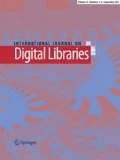Abstract
Scientific communities are under increasing pressure from funding organizations to publish their raw data, in addition to their traditional publications, in open archives. Many scientists would be willing to do this if they had tools that streamlined the process and exposed simple provenance information, i.e., enough to explain the methodology and validate the results without compromising the author’s intellectual property or competitive advantage. This paper presents Provenance Explorer, a tool that enables the provenance trail associated with a scientific discovery process to be visualized and explored through a graphical user interface (GUI). Based on RDF graphs, it displays the sequence of data, states and events associated with a scientific workflow, illustrating the methodology that led to the published results. The GUI also allows permitted users to expand selected links between nodes to reveal more fine-grained information and sub-workflows. But more importantly, the system enables scientists to selectively construct “scientific publication packages” by choosing particular nodes from the visual provenance trail and dragging-and-dropping them into an RDF package which can be uploaded to an archive or repository for publication or e-learning. The provenance relationships between the individual components in the package are automatically inferred using a rules-based inferencing engine.
Similar content being viewed by others
References
Altintas, I., Barney, O., Jaeger-Frank, E.: Provenance collection support in the Kepler scientific workflow system. In: International provenance and annotation workship (IPAW’06). Chicago (2006)
Oinn T. (2004). Taverna: A tool for the composition and enactment of bioinformatics workflows. Bioinformatics J. 20(17): 3045–3054
Majithia, S., et al.: Triana: A Graphical Web Service Composition and Execution Toolkit. in IEEE International Conference on Web Services (ICWS’04). IEEE Computer Society (2004)
Brown, J.L., et al.: GridNexus: a grid services scientific workflow system. Int. J. Comput. Info. Sci. 6 (2), (2005)
Schraefel, M.C., et al.: Breaking the Book: Translating the chemistry lab book into a pervasive computing lab environment. in CHI04. Vienna (2004)
Gibson, A., et al.: myTea: connecting the web to Digital Science on the Desktop. in World Wide Web Conference. 2006. Edinburgh
Lagoze, C., Hunter, J.: The ABC Ontology and Model. J. Digi. Info. 2 (2), (2001)
Bose, R., Frew, J.: Composing lineage metadata with XML for custom satellite-derived data products. in Scientific and Statistical Database Management, 2004. In: Proceedings of 16th International Conference (2004)
Myers, J.D., Pancerella, C., Lansing, C., Schuchardt, K.L., Didier, B.: Multi-scale science: supporting emerging practice with semantically derived provenance. In: ISWC 2003 Workshop: semantic web technologies for searching and retrieving scientific data. Sanibel Island (2003)
Zhao, J., et al.: Using Semantic Web technologies for representing e-science provenance. In: 3rd international semantic web conference. Hiroshima (2004)
Freire, J., et al.: Managing rapidly-evolving scientific workflows. In: International provenance and annotation workship (IPAW’06). Chicago (2006)
Lagoze, C., et al.: Fedora: An architecture for complex objects and their relationships. J. of Digit. Libr. (2005)
Sompel H. (2005). aDORe: A modular, standards-based digital object repository. Comput. J. 48(5): 514–535
Hunter J. and Nack F. (2000). An Overview of the MPEG-7 desiption definition language (DDL) proposals. Signal Process. Image Communi. J. Special Issue on MPEG-7 16: 271–293
Bekaert, J., Hochstenbach, P., Van-de-Sompel, H.: Using MPEG-21 DIDL to represent complex digital objects in the Los Alamos National Laboratory Digital Library. D-Lib Mag. 9 (11), (2003)
Hunter J. and Cheung K. (2005). Generating eScience Workflows from Statistical Analysis of Prior Data. in APAC’05. Royal Pines Resort, Gold Coast
Hunter, J., Drennan, J., Little, S.: Realizing the Hydrogen Economy through Semantic Web Technologies. IEEE Intell. Syst. J.—Special Issue on eScience 40–47, (2004)
Carroll, J.J., et al.: Jena: implementing the semantic web recommendations. In: Proceedings of the 13th international World Wide Web conference on Alternate track papers & posters. ACM Press, New York pp. 74–83 (2004)
McCarthy, P.: Search RDF data with SPARQL: SPARQL and the Jena Toolkit open up the semantic Web, in developerWorks. IBM (2005)
O’Connor, M., et al.: Writing Rules for the Semantic Web Using SWRL and Jess. In: 8th International Protege Conference, Protege with Rules Workshop. Madrid (2005)
Crawford J.M. and Kuipers B.J. (1991). Algernon—a tractable system for knowledge-representation. SIGART Bull. 2(3): 35–44
Alder, G.: The JGraph Swing Component, in Department of Computer Science. Federal Institute of Technology ETH, Zurich (2002)
Gangemi, A., et al.: Sweetening Ontologies with DOLCE. In: 13th International conference on knowledge engineering and knowledge management. Siguenza (2002)
Weber, R.: Ontological foundations of information systems. Monograph No. 4. Coopers& Lybrand Accounting Research Methodology, Melbourne (1997)
Colomb, R.M.: Formal versus Material Ontologies for information Systems interoperation in the Semantic Web. Comput. J. 49 (1), (2006)
Digital Broadband Content: Scientific Publishing, in SourceOECD Science & Information Technology. OECD - Organisation for Economic Co-operation and Development (2005)
Mackenzic, S.: D Span for E-print archives. High energy Phys Libr webzine (9), (2004)
Author information
Authors and Affiliations
Corresponding author
Rights and permissions
About this article
Cite this article
Hunter, J., Cheung, K. Provenance Explorer-a graphical interface for constructing scientific publication packages from provenance trails. Int J Digit Libr 7, 99–107 (2007). https://doi.org/10.1007/s00799-007-0018-5
Published:
Issue Date:
DOI: https://doi.org/10.1007/s00799-007-0018-5




